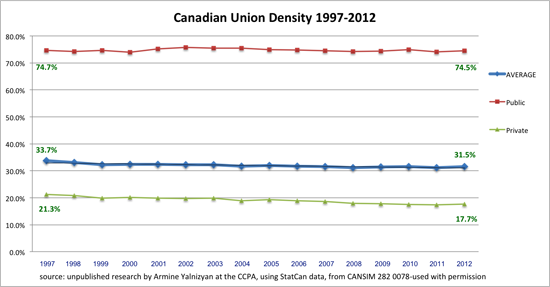Please support our coverage of democratic movements and become a monthly supporter of rabble.ca.
—
In late March, at the Broadbent Institute Summit in Ottawa, former Australian Prime Minister Julia Gillard made the point that social democrats have a tendency to conduct themselves like dinosaurs in search of an ice age; by which she meant that we are most content when we are contemplating our own demise.
Her comments brought to mind the current state of labour movement discourse in Canada. The prevailing view seems to be that the labour movement, particularly in the private sector, is in such rapid decline that we must dramatically change and immediately remake our movement or face possible annihilation. Proponents of this position point to allegedly dramatic drops in trade union density in the private sector.
My first thought is that trade unions are the only organizations that publicly emphasize and exaggerate their own weakness and imminent demise. Moreover, the narrative that unions are in decline is one that the right wing media loves to run — how many articles in The Globe and Mail have made this exact point in recent years?
Of course it is true that trade union density in Canada is in decline. It is a long-term damaging trend, but it is not nearly as devastating as some might claim. First, according to Statistics Canada, overall Union density in Canada from 1997 to 2012 declined from 33.7 percent to 31.5 per cent — not a precipitous decline. In the public sector, trade union density remains a very robust: 74.5 per cent — a fact that should be celebrated. In the private sector, from 1997 to 2012, unionization rates declined from 21.3 per cent to 17.7 per cent, with most of that decline taking place place prior to 2008. After 2008 (17.9 per cent) private sector unionization rates dipped, but then went up in 2012.
Yes, private sector union density in Canada went up in 2012 from 17.4 per cent to 17.7 per cent (see the chart below, prepared courtesy of research by Armine Yalnizyan).

The biggest absolute and relative decline in unionization rates is in manufacturing, and most of this decline is driven by job loss in the manufacturing sector. This suggests that the best thing the union movement could do to build density in the private sector is help to elect governments that have a real industrial strategy aimed at rebuilding the Canadian manufacturing sector.
The truth is that by international standards, the Canadian labour movement is somewhat of a success story. When compared to our brothers and sisters in the U.S. and the U.K, Canada’s unionization rates have remained relatively strong and stable. Indeed, although it is difficult to compare unionization rates across different labour relations regimes, Canada currently has higher union membership density than the U.K, Australia, New Zealand and the U.S.
Of course, I am not arguing for complacency. The trends are in the wrong direction and the union movement needs to continue to reflect on how new approaches can lead to real growth. Yes, unions need to work to improve our public image and we need to re-engage our membership. We need to build better and more sustainable coalitions with other progressive organizations.
We also need to be outward looking and more international in our focus. One of the positive changes in our union over the last number of years has been our increased focus and capacity to run truly global campaigns. A recent example of this capacity can be found in our global campaign against Rio Tinto, the third largest mining company in the world. From January to July 2012, Rio Tinto locked out 780 steelworkers in Alma, Quebec, demanding drastic wage cuts for the next generation of workers.
However, with great solidarity from the local union members, the community, and most notably our global allies, the members of Local 9490 beat back Rio Tinto’s agenda and returned to work with a good contract that provides good wage increases and limits on the employer’s demand to contract out work.
The key to the victory was the global campaign that was able to mobilize solidarity in the UK, Australia, New Zealand, South Africa and the U.S. Ultimately, we have no doubt that Rio Tinto withdrew their concessionary demands because they could no longer tolerate the public relations disaster they were facing when we took the campaign directly to the London Olympics and demanding that Rio Tinto be thrown off the podium as an Olympic sponsor.
As a movement, we need to explore and create new ways and structures to truly stand up to global multinationals and exercise power globally. We need to learn from successes, like the Rio Tinto lockout, and communicate that we can, in fact, turn the tide against globalization and negotiate good contracts for our members, even when dealing with a powerful multinational.
In order to grow, workers must see the concrete, positive benefits of joining a union. At the recently concluded CLC Convention in Montreal, there was very little discussion about victories at the bargaining table or organizing successes. Instead, we spent a lot of time lamenting our problems and listening to windy exhortations for change within the movement.
Perhaps our discourse should focus more on the role that the trade union movement has played in the creation of a more just and equal society, and less on our own internal issues. No one outside the labour movement understands our own internal debates anyway.
And we need to stop talking about our own imminent demise. No one wants to join a movement that is on its death bed.
Mark Rowlinson is the Executive Assistant to the Canadian National Director, United Steelworkers.
Check out the rest of the UP! Canadian labour rising series here.
Please support our coverage of democratic movements and become a monthly supporter of rabble.ca.



